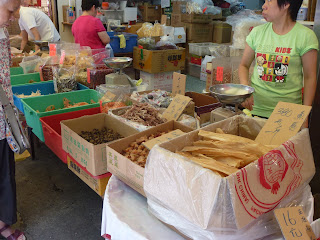This morning, we went back to 鴻記 for breakfast. I had what could be considered the quintessential Cantonese breakfast:
A bowl of century egg and pork congee (皮蛋瘦肉粥) and a plate of fried noodles (豉油王炒麵). Century eggs are made by burying a duck egg in a caustic lime and clay mixture for a few months. When the egg is taken out, the white has achieved a dark brown jelly-like consistency and the yolk has become a creamy grey substance with a strong odour of sulfur. They taste sort of like a very astringent version of dried fish or a ripened cheese, and CNN once called them the most disgusting food in the world.Castle Peak Road (青山公路) is the longest road in Hong Kong. It starts in Kowloon and works its way up the northwestern New Territories. Today, we followed it from Sham Tseng to Tuen Mun (屯門) and then onward to Yuen Long (元朗), where we took the West Rail Line (purple on the map) back to Tsuen Wan.
This part of the New Territories is some of the most spacious in Hong Kong, with some nice countryside vistas next to suburban skyscrapers.
Some sort of political campaign. These have been popping up everywhere, as apparently there's a Legislative Council (LegCo) election coming up. I'll try to make a local politics post soon, stuff's been getting really interesting lately.
Heading west along the coast:
On the
EDIT: I mean left. Driving on the wrong side of the road does strange things to the mind!
 |
In front is Castle Peak, the namesake of the road.
|
Heading into Tuen Mun, a familiar sight greets us:
Skyscrapers bounded on both sides by forested green mountains.
We decide to stop for a bit and walk around the local markets in Tuen Mun:
 |
| Dried seafood, considered both delicacy and medicine. |
 |
| Traditional chinese butchers. None of the gory bits hidden! |
Light rail. Those two words, in Toronto, have carried a lot of political weight these past few months. Here, there's been a light rail system within and between the towns of Tuen Mun, Tin Shui Wai (天水圍), and Yuen Long for 24 years. The technology used is somewhat different, as these trains have high floors as opposed to the low floor design preferred in Toronto, which leads to raised platforms:
Its fare structure is made up of zones, and you tap in when you get onto the platform and tap out wherever you get off. There are no gates or barriers; the whole system works on honour. The light rail here is great for travelling between these New Territories suburbs, as the stops are more closely spaced for shorter walking distances, and yet the trains reach and maintain good speeds and headways.
Here's something that would look a bit quirky to a North American:
As I've said before, "subway" here denotes a pedestrian underpass of some sort, but doesn't this particular one even look like a station entrance?
Hong Kongers have no good English name for their urban rail system, simply calling it the MTR. In Chinese, words often form as a contraction or portmanteau of other, root words. For example, the MTR, and similar underground rail systems, is called "地鐵", short for "地下" (underground) "鐵路" (railway).
Within the town of Yuen Long, the light rail forms the median of Castle Peak Road:
... and Eglinton and Sheppard are a lot wider than Castle peak Road!
We ate at this "Italian" restaurant in Yuen Long:
 |
| The decor apparently hasn't changed in 30 years. |
As is typical for Hong Kong "western" restaurants, known affectionately as "Soy Sauce Western" (豉油西餐), the dishes are adapted to local tastes. So we have frozen veggies, limp spaghetti covered in some ketchup-based sauce, and meat that's been tenderized with cornstarch.
Like American-Chinese in reverse!
For dessert, we went to a popular joint in Yuen Long, known for its "B Boy's grass jelly" (B仔涼粉):
My aunt, for whatever reason, wanted a plate of chicken wingtips:
And here's the main attraction:
I don't know if you can tell from the picture, but this bowl is huge. Basically, it's a giant fruit salad, with peaches, papaya, pineapple, watermelon, cantaloupe, honeydew, lychees, and longans. It's topped with coconut jelly (the cubes you see on top), and at the bottom is the grass jelly (you can't see it, but it's black and has a nice chinese herbal taste). At $65 ($8.70CAD), it's more than enough for 4-6 people to share.
And here's the local fruit market, where the fruit above ostensibly comes from:
Tired from walking in the hot sun all day, we headed back:
On the way, there was a nice view of Shenzhen (in mainland China) in the distance:
The available space in the New Territories allow buildings to be quite a bit shorter than elsewhere, reaching some 4-6 floors.



















No comments:
Post a Comment